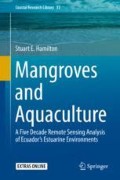Abstract
To assess the changes in landuse and landcover resulting from the shrimp farm expansion occurring in each of the study areas, a remote sensing analysis of each estuary in Ecuador is conducted. This remote sensing analysis documents mangrove forest landuse and landcover (LULC) change as well as shrimp farm LULC change that occurred in each of the estuaries. Also, the remote sensing analysis pinpoints the approximate time the LULC transition occurred and the exact location of these LULC changes. The remotely-sensed data has the required spatial, temporal, and radiometric resolutions to detect if shrimp farms directly displaced mangrove forest at the sub-estuary level. This remote sensing analysis can then be used in Chap. 5 to answer the critical question of how much aquaculture-driven LULC change has occurred at the local level since commercial shrimp farms arrived in each estuary in Ecuador. The primary earth observing system (EOS) used to conduct the LULC change analysis is the Landsat program as it has the required resolutions to achieve these stated goals. This chapter describes a repeatable and widely-applicable method based on remotely sensed data synthesis that can be applied to other locations or even other landocovers. All the input, processing, and output data used or generated are provided in an accompanying website.
Access this chapter
Tax calculation will be finalised at checkout
Purchases are for personal use only
References
Abrams M, Hook S, Ramachandran B (2002) ASTER user handbook, version 2. Jet propulsion laboratory 4800:135
Ball GH, Hall DJ (1965) ISODATA, a novel method of data analysis and pattern classification. Stanford Research Institute, Menlo Park
Barsi JA, Lee K, Kvaran G, Markham BL, Pedelty JA (2014) The spectral response of the Landsat-8 operational land imager. Remote Sens 6(10):10232–10251
Brunn A, Bahloul S, Hoffmann D, Anderson C (2016) Recent progress in in-flight radiometric calibration and validation of the RapidEye constellation of 5 multispectral remote SENSING satellites. In, Cham, 2016. Image and Video Technology – PSIVT 2015 Workshops Springer International Publishing, pp 273–284
Chander G, Markham B (2003) Revised Landsat-5 TM radiometric calibration procedures and postcalibration dynamic ranges. IEEE Trans Geosci Remote Sens 41(11):2674–2677
ESRI (2016) http://desktop.arcgis.com/en/arcmap/10.3/tools/spatial-analyst-toolbox/raster-calculator.htm. ESRI. http://desktop.arcgis.com/en/arcmap/10.3/tools/spatial-analyst-toolbox/raster-calculator.htm. Accessed 12 Jan 2018
ESRI (2018) How maximum likelihood classification works. ESRI. http://desktop.arcgis.com/en/arcmap/10.3/tools/spatial-analyst-toolbox/how-maximum-likelihood-classification-works.htm. Accessed 12, 2018
Hamilton SE, Castellanos-Galindo GA (2018) UAV derived, 6 cm resolution. GeoTIFF, RGB, Projected, GIS-ready raster dataset of Rio Preguicas Mangrove Stand, Maranhão State, Brazil
Hamilton SE, Castellanos-Galindo GA, Millones-Mayer M, Chen M (2018) Remote sensing of mangrove forests: current techniques and existing databases. In: Makowski C, Finkl CW (eds) Threats to mangrove forests: hazards, vulnerability, and management, vol 25. Springer, Cham, pp 497–520. https://doi.org/10.1007/978-3-319-73016-5_22
Heumann BW (2011) Satellite remote sensing of mangrove forests: recent advances and future opportunities. Prog Phys Geogr 35(1):87–108
Irish RR (2000) Landsat 7 science data users handbook. National Aeronautics and Space Administration, Report 2000, pp 415–430
Jensen JR (2005) Introductory digital image processing: a remote sensing perspective, Prentice Hall series in geographic information science, 3rd edn. Prentice Hall, Upper Saddle River
Jensen JR (2007) Remote sensing of the environment: an earth resource perspective, Prentice Hall series in geographic information science, 2nd edn. Prentice Hall, Upper Saddle River
Kuenzer C, Bluemel A, Gebhardt S, Quoc TV, Dech S (2011) Remote sensing of mangrove ecosystems: a review. Remote Sens 3(5):878–928
Masek JG, Vermote EF, Saleous NE, Wolfe R, Hall FG, Huemmrich KF, Gao F, Kutler J, Lim T-K (2006) A Landsat surface reflectance dataset for North America, 1990-2000. IEEE Geosci Remote Sens Lett 3(1):68–72
NASA, METI, AIST, Japan Spacesystems, U.S./Japan ASTER Science Team (2018) ASTER on-demand L2 surface reflectance VNIR and SWIR crosstalk-corrected, vol 2018. LP DAAC, Washington, DC. https://doi.org/10.5067/ASTER/AST_07XT.003
NIMA (2000) Department of defense world geodetic system 1984: its definition and relationships with local geodetic systems. 3rd, Amendment 1 edn. NIMA, Bethesda
Otero V, Van De Kerchove R, Satyanarayana B, Martínez-Espinosa C, Fisol MAB, Ibrahim MRB, Sulong I, Mohd-Lokman H, Lucas R, Dahdouh-Guebas F (2018) Managing mangrove forests from the sky: forest inventory using field data and unmanned aerial vehicle (UAV) imagery in the Matang Mangrove Forest Reserve, peninsular Malaysia. For Ecol Manag 411:35–45
QGIS Development Team (2016) QGIS user manual: raster calculator
Richards JA, Richards J (1999) Remote sensing digital image analysis, vol 3. Springer, Berlin
Ruwaimana M, Satyanarayana B, Otero V, Muslim AM, Syafiq M, Ibrahim S, Raymaekers D, Koedam N, Dahdouh-Guebas F (2018) The advantages of using drones over space-borne imagery in the mapping of mangrove forests. PLoS One 13(7):e0200288
Tian J, Wang L, Li X, Gong H, Shi C, Zhong R, Liu X (2017) Comparison of UAV and WorldView-2 imagery for mapping leaf area index of mangrove forest. Int J Appl Earth Obs Geoinf 61:22–31
USGS (2018) Landsat 8 surface reflectance code (LASRC) product guide, vol 1. USGS, Sioux Falls
USGS (2019) Landsat surface reflectance Level-2 science products support land surface change studies. USGS. https://landsat.usgs.gov/landsat-surface-reflectance-data-products. Accessed 12 Jan 2018
USGS, US Dept. of Interior (2018) Landsat Missions. USGS. https://landsat.usgs.gov/. Accessed 12 Jan 2018
Williams D (2009) Landsat-7 science data User’s handbook. National Aeronautics and Space Administration, p 186
Woodcock CE, Allen R, Anderson M, Belward A, Bindschadler R, Cohen W, Gao F, Goward SN, Helder D, Helmer E (2008) Free access to Landsat imagery. Science 320(5879):1011–1011
Zanter K (2016) Landsat 8 (L8) data users handbook. Landsat Science Official Website Available online: https://landsat usgs gov/landsat-8-l8-data-users-handbook. Accessed 20 Jan 2018)
Author information
Authors and Affiliations
4.1 Supplementary Electronic Material (S)
Rights and permissions
Copyright information
© 2020 Springer Nature Switzerland AG
About this chapter
Cite this chapter
Hamilton, S.E. (2020). Assessing 50 Years of Mangrove Forest Loss Along the Pacific Coast of Ecuador: A Remote Sensing Synthesis. In: Mangroves and Aquaculture. Coastal Research Library, vol 33. Springer, Cham. https://doi.org/10.1007/978-3-030-22240-6_4
Download citation
DOI: https://doi.org/10.1007/978-3-030-22240-6_4
Published:
Publisher Name: Springer, Cham
Print ISBN: 978-3-030-22239-0
Online ISBN: 978-3-030-22240-6
eBook Packages: Earth and Environmental ScienceEarth and Environmental Science (R0)

